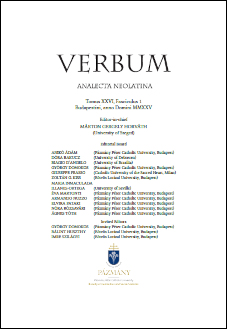Published 10-07-2025
Keywords
- language variation,
- 16th century,
- Hungarian history
How to Cite

This work is licensed under a Creative Commons Attribution 4.0 International License.
Abstract
In the mid-16th century, the Count of Cassano, Giovanni Battista Castaldo was commissioned by King Ferdinand of Habsburg to take over Hungary from Queen Isabella Jagellone, who was forced to leave the country and retreat to Silesia. When Castaldo’s army, consisting of Spaniards, Hungarians, German speakers and Italians entered Transylvania, the language situation became even more complicated. The documents of the expedition (which also included the killing of Archbishop György Martinuzzi) are collected in a miscellaneous codex that ended up in the Biblioteca Ambrosiana, known as the Castaldo Codex. The languages and varieties recorded in the documents are a faithful mirror of the linguistic situation in this part of the world around 1550. Through transcribed and analysed portions of the text, an attempt is made to show how the analysis of language varieties can help historical research.
References
- Carpentieri, Ch. M. (2012): Ungheria 1551–1552. Nuovi possibili spunti sulle campagne imperiali contro il turco tratti dal codice ambrosiano G 275 inf. Verbum Analecta Neolatina XIII/2: 464–476.
- Carpentieri, Ch. M. (2013): Per un primo censimento delle fonti storiche e letterarie ungheresi dei secc. XV–XVII in tre biblioteche lombarde. Tesi di dottorato, relatore: Giuseppe Frasso, Università Cattolica del Sacro Cuore di Milano.
- Carpentieri, Ch. M. (2015): Minima hungarica Jegyzetek a lombardiai könyvtárakban őrzött, magyar vonatkozású XV–XVII. századi kéziratokról és nyomtatványokról [Appunti sui manoscritti e stampe dei secoli 15–17 con riferimenti all’Ungheria, custoditi nelle biblioteche della Lombardia]. In: Domokos et al. (2015: 31−46).
- Ceruti, A. (1975): Inventario Ceruti dei manoscritti della Biblioteca Ambrosiana, II, Trezzano sul Naviglio: Etimar.
- De Caro, G. (1978): Castaldo, Giovanni Battista In: Dizionario Biografico degli Italiani (DBI), 21, Roma: Istituto della Enciclopedia Italiana.
- DBI = Dizionario biografico degli italiani, Roma, Istituto dell’Enciclopedia Italiana, 100 voll., 1960−2010. www.treccani.it/biografie
- Domokos, Gy. (2024): A Castaldo-kódex nyelvi rétegei [Gli strati linguistici del Codice Castaldo]. In: I. Boros (a cura di) Evolvo libros uberes. Scriptorium VI, in corso di stampa.
- Domokos, Gy. & A. Hegedűs (2023): A Castaldo-kódex és a benne található magyar nyelvű forrás [Il Codice Castaldo e la fonte in lingua ungherese che esso contiene]. Magyar Nyelv 119: 122–127.
- Domokos, Gy., M. Norbert & A. Nuzzo 2015: Vestigia. Mohács előtti magyar források olasz könyvtárakban [Vestigia. Fonti ungheresi precedenti alla battaglia di Mohács in biblioteche italiane]. Piliscsaba: PPKE BTK.
- Hegedűs, A. & L. Papp (a cura di) (1991): Középkori leveleink [Le nostre lettere medievali]. Budapest: Tankönyvkiadó.
- Kovács, Zs. (2012): Castaldo-kódex [Il Codice Castaldo]. MAMÜL XIII: 345–346.
- Kovács, Zs. (2012−2013). Horváth György: Fráter György epitáfiuma [L’epitaffio di Frate György] (Milano, Biblioteca Ambrosiana, G 275 inf. ff . 181r–182r). Lymbus: 51−56.
- Kőszeghy, P. (a cura di) (2012): Magyar művelődéstörténeti lexikon [Lexicon della storia della civiltà ungherese], 14 voll. Budapest: Balassi Kiadó, 2012.
- Senatore, G. (1887): Della patria di Gio. Battista Castaldo (generalissimo di Carlo V), Napoli: A. Valle.

